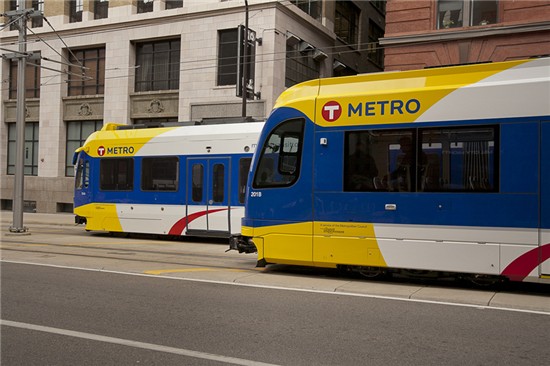
For the last four years, Lisa Nguyen-Gaulke has relied on the METRO Blue Line to reach her job in downtown Minneapolis, a trip she estimates takes half the time she’d spend commuting by car from her Standish-Ericsson home.
Nguyen-Gaulke also uses the Blue Line to get to Twins games or other weekend events and as an easy connection to the Minneapolis-St. Paul International Airport. Combined with their bikes, Nguyen-Gaulke’s use of the Blue Line allowed she and her husband to downsize to a single vehicle two years ago.
“It makes a big difference, especially with gas as high as it’s been recently,” Nguyen-Gaulke said this week.
Nguyen-Gaulke is among a growing number of residents who – nine years after the Blue Line’s opening and more than 30 years since it was first envisioned – have come to see light rail as an integral part of their daily lives.
As the Blue Line marks another anniversary today, here's a quick snapshot of how the state's first light rail line is performing and a look at what is yet to come.
- > Ridership is exceeding expectations. Nearly 10.5 million customers boarded Blue Line trains in 2012, a record number of passengers for the 11-mile light rail line. Ridership levels have been trending nearly 30 percent ahead of projections for the year 2020. In Metro Transit's 2012 Customer Survey, 60 percent of respondents said they were on their way to work; 15 percent were running errands and 9 percent were on their way to school. Riders said they chose transit because they had no access to a vehicle, wanted to avoid stress and avoid gas and parking expenses. More than 42 percent of passengers have ridden for more than five years and more than 90 percent rated service as “good” or “excellent.”
-
- > Development is surging. At the north end of the Blue Line, housing and office projects are planned or underway in the North Loop and near Target Field. Directly adjacent to the Nicollet Mall Station, a 26-story apartment building is rising from the ground -- the first high-rise in Minneapolis in 30 years. Plans to add offices, green space and apartments near the site of the new Vikings Stadium are taking shape. East of the 38th Street Station, a 180-unit apartment building, Longfellow Station, is nearing completion. And in Bloomington, plans for a 50-acre transit-oriented development around the Bloomington Central Station are taking shape as the Mall of America continues to expand.
-
- > Property values along the corridor have been strengthened. Single-family homes within a quarter-mile of the Blue Line have sold for 4.2 percent more than homes in a comparison area, with values increasing an average of $5,000 per home. A 2013 study found home values within a half-mile of hi-frequency transit like the Blue Line performed 48 percent better during the recession compared to those farther away.
-
- > Connectivity is growing. With the opening of the METRO Red Line last weekend, customers in the south metro have access to a frequent, all-day service connecting to the Blue Line at the Mall of America Transit Station. In 2014, the METRO Green Line will provide light rail passengers with a convenient connection to St. Paul and the University of Minnesota. When the Interchange transit hub adjacent Target Field opens next spring, connections between transit services, including the Northstar Commuter Rail line and bus service, will further improve. Future connections include the Snelling Bus Rapid Transit Line, which would run from the 46th Street Station and along Snelling Avenue to Rosedale Center, and the Green Line Extension, which would run light rail between Minneapolis and Eden Prairie.
-
- > Service will continue to improve. A dozen new light rail vehicles have been added to the Blue Line fleet in the past few months, providing service with all three-car trains during peak periods and special events. The vehicles are designed to be more energy-efficient and comfortable for passengers. Planned streetscape improvements on Hiawatha Avenue will make the corridor more inviting to pedestrians and bikers. And reconfigured traffic signal technology will help move traffic more quickly along Hiawatha Avenue. A growing police force will provide additional law enforcement presence throughout the entire Metro Transit system.